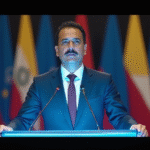The Power of Visionary Thinking: Lessons from Kennedy’s Moon Landing
In 1961, John F. Kennedy announced that the United States would land a man on the moon before the decade’s end. At the time, the necessary technology, rocket, and clear roadmap did not exist; only a vision drove this ambitious goal.
Over six decades later, numerous organizations face equally ambitious challenges: reinventing industries, addressing climate crises, transforming mental health, or designing smart cities. However, their mistake is attempting to tackle these issues from the present, using spreadsheets that project the past. What if they started by thinking backwards?
Moonshot Foresight: A Mindset Shift for Future-Oriented Innovation
The Moonshot Foresight approach proposes a mindset shift to think from the future, connecting a radical vision with concrete actions in high-uncertainty environments.
A moonshot is an audacious, exploratory, and transformative initiative aiming to solve complex problems through radical and exponential solutions. These are high-impact bets, such as curing incurable diseases, decarbonizing the economy, or extending human life.
Foresight, on the other hand, is the discipline that studies and designs possible futures to make better decisions in the present. It does not predict the future but expands our understanding of what could happen.
Why Think from the Future?
Traditional strategic thinking—which starts from the present and projects forward—works well in stable environments. But what happens when the environment is volatile, uncertain, complex, and ambiguous (VUCA)?
When it comes to radical innovations or moonshots, traditional strategic thinking falls short. Anchored in the past, it projects trends, extrapolates data, and seeks efficiency. However, truly transformative projects, like rapid vaccine development or radical decarbonization, require imagining the destination first and then building the path.
Unlike approaches like backcasting, which also starts from a future vision to work backward, moonshot foresight incorporates an adaptable strategic and operational perspective for high-uncertainty, high-risk environments, focusing on how to mobilize resources, allies, and investment along the way.
What is Moonshot Foresight?
Moonshot foresight is a methodology developed as part of a master’s thesis project in Strategic Futures at the School of Governance and Public Transformation and EGADE Business School of Tecnológico de Monterrey.
Its goal is to make transformative visions executable. It structures the innovation process into six phases:
- Future visualization and alignment with a Massive Transformative Purpose (MTP): Formulate an audacious vision—a nearly impossible yet socially relevant goal—before defining an innovative idea.
- Segmentation into strategic milestones: Divide the moonshot into achievable stages instead of an all-or-nothing approach. Each milestone represents technological, market, or knowledge advancement.
- Identification of strategic opportunities within each milestone: Each step can generate peripheral benefits (products, licenses, learnings) that provide immediate or intermediate value.
- Sub-visions within the project: Develop a strategic narrative for each milestone, allowing investors or allies to connect with specific project parts without committing to the entire journey.
- Materialization of benefits and impact measurement: Establish specific indicators for each stage, from operational efficiency to technical validation or commercial traction.
- Dynamic monitoring and adjustment: The roadmap is not rigid; it adapts based on learnings, environmental signals, or new opportunities.
This approach enables navigating uncertainty and demonstrating tangible value from early stages, crucial for attracting funding, political support, or social legitimacy.
Breaking Down into Milestones to Reduce Risk
This methodology offers a key strategic opportunity for innovation leaders. First, it reduces perceived risk by structuring large bets into measurable intermediate milestones, making each stage justifiable as a reasonable investment rather than an aimless adventure.
Second, it increases strategic resilience by inviting future-oriented thinking, forcing teams to consider various scenarios and adaptability to change. Finally, it activates the appropriate ecosystem: an ambitious purpose mobilizes talent, allies, and partners more effectively than incremental goals, provided it’s backed by a clear structure making it executable.
As Vinod Khosla, a fusion energy investor, said: “The key to making a radical project acceptable to investors is breaking it down into evaluable and progressively fundable milestones.” This logic has also been highlighted by Pablo Rodríguez, former CEO of Alpha, Telefónica’s moonshot factory: “An effective way to reduce risk is to break the project into smaller, relatively short-term milestones. This strategy allows the team to focus on getting clear and quick answers without diverting too many resources before validating an idea.”
The Power of Strategic Imagination
In an environment where challenges are systemic and changes are exponential, the convergence between innovation and futures is not a trend but a critical competency. Organizations that successfully integrate strategic imagination with rigorous execution will be better prepared to lead transformation.
Today, innovation is not just about creating new products; it’s about imagining different futures. Great transformations do not emerge from analysis but from structured imagination.
If we want to tackle the most complex challenges of our time, we need leaders who start from the end: that audacious vision that may seem uncomfortable now but could change everything tomorrow. The future is not predicted; it’s designed. But to design it, we first need to imagine it.
The Authors
- Alfonso Ávila Robinson, Professor at the Department of Technology Entrepreneurship at EGADE Business School, Tecnológico de Monterrey, and Co-chair of the UNESCO Chair on Anticipatory Leadership for Innovative Futures.
- Luis Alberto Palacios Parga, Manager of Forecasting and Analytics at Panduit Corporation and primary author of the Moonshot Foresight project at Tecnológico de Monterrey.






